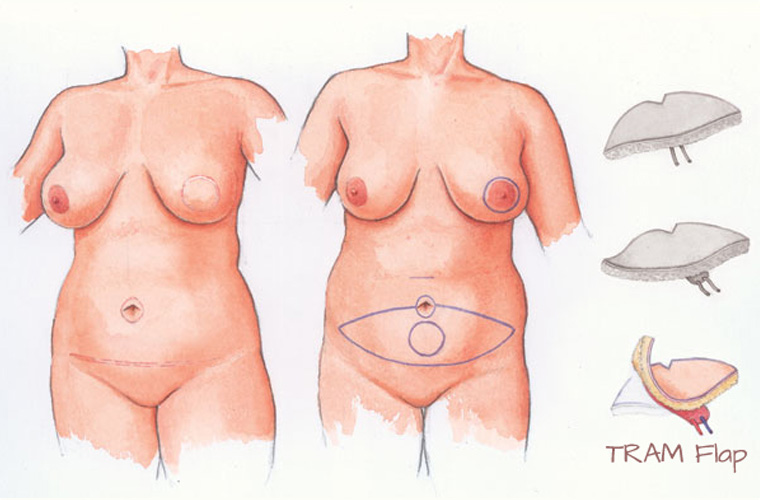TRAM Flap
In the free microsurgical TRAM flap some muscle as well as skin and fat from the abdomen is transplanted into the breast area.
The muscle is necessary as a carrier for the blood supply. Again there is usually enough tissue to build a breast without the use of an implant when removing the tissue from the abdomen area. The abdomen is tightened and closed as in a “tummy tuck”.
This is also a major procedure requiring 4 hours of surgery and 5-7 days in hospital. Here, because muscle is taken away, a mesh is usually applied to reinforce the abdomen in order to prevent the occurrence of weakness and hernia.
Previously, the ‘pedicled’ TRAM flap, where even more rectus muscle (one of the “crunch” muscles) is taken and the blood supply derived from a smaller artery at the top of the muscle. This is a faster procedure, does not require microsurgery as the blood supply is still connected, but a large mesh is required as weakness and hernias are more common as well as partial loss of the reconstruction. The pedicled TRAM is not used in our unit for routine breast reconstruction due to these limitations. The operation lasts about three to four hours with a four to five day stay in hospital.
Over the years, plastic surgeons have become more adept at leaving more muscle behind leading to the development of the muscle-sparing TRAM and the DIEP flap as described in the relevant pages. Autologous techniques, using the patients own tissue are remarkably successful at producing a natural and permanent reconstruction and once completed can negate the need for revision surgery later as they age better with the patient’s body.
(‘TRAM’ flap is derived from Transverse Rectus Abdominus Myocutaneous Flap, as the skin paddle on the tummy is orientated horizontally and the blood supply to it comes from the ‘6-pack’ muscle below called the rectus abdominus. A flap is a piece of skin, muscle, nerve or bone that has its own defined blood supply when moved around by plastic surgeons as opposed to a graft which has no blood supply but picks it up from a healthy wound bed.)
Other Procedures
Please go through the information below in your own time to help your understanding of the options available.

